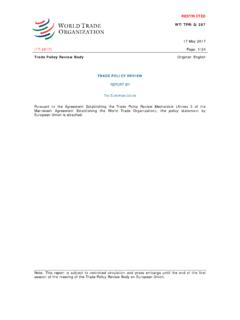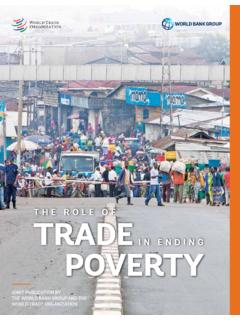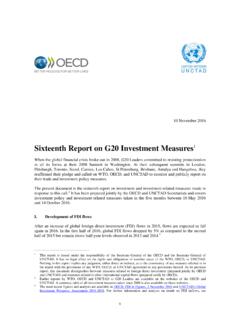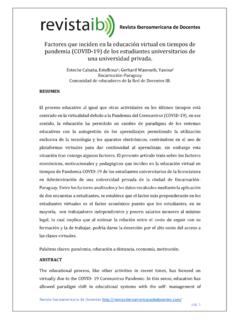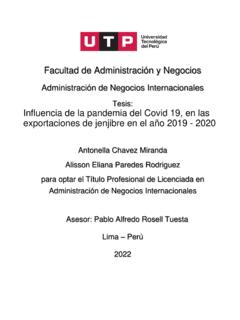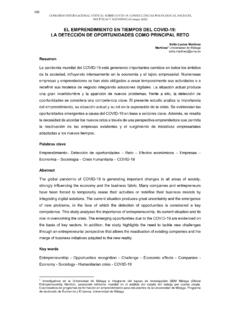Transcription of E-COMMERCE, TRADE AND THE COVID-19 PANDEMIC
1 4 May 2020. Page: 1/8. Original: English E-COMMERCE, TRADE AND THE COVID-19 PANDEMIC . INFORMATION NOTE 1. KEY POINTS. The enforcement of social distancing, lockdowns and other measures in response to the COVID-19 PANDEMIC has led consumers to ramp up online shopping, social media use, internet telephony and teleconferencing, and streaming of videos and films. This has resulted in spikes in business-to-consumers (B2C) sales and an increase in business-to-business (B2B) e-commerce. 2 The increase in B2C sales is particularly evident in online sales of medical supplies, household essentials and food products. Demand has also increased for internet and mobile data services. The network capacity and spectrum to accommodate the shift to online activities has urgently had to be adapted by both operators and governments. Demand has fallen, however, for certain services with a large online component, such as tourism services.
2 E-commerce for goods and services TRADE has been adversely impacted by the same factors that have caused disruption in supply and demand overall. Such disruptions have resulted in delivery delays or outright cancellation of orders. Several other e-commerce-related challenges have arisen or been further amplified during this PANDEMIC . These include price gouging ( increasing prices to unreasonably high levels), product safety concerns, deceptive practices, cybersecurity concerns, the need for increased bandwidth, and development-related concerns. The PANDEMIC has highlighted the glaring need to bridge the digital divide, both within and across countries, given the central role the digital economy has played during the crisis. Many traditional obstacles have been accentuated and have continued to hamper greater participation in e-commerce activities by small producers, sellers and consumers in developing countries, particularly in least-developed countries (LDCs).
3 This has underscored the need for efficient and affordable information and communications technology (ICT). services, such as telecommunication, computer and other IT services and emerging technologies. Governments have adopted new measures, and the private sector has also acted, to respond to and ensure that e-commerce can help to alleviate some of the challenges faced in combatting the virus. These have included increasing network capacity, offering expanded data services at little or no cost, lowering or scrapping transaction costs on digital payments and mobile money transfers, improving delivery services and other logistics, using digital tools to enforce measures and disseminate information, promoting telehealth services, and leveraging ICT for surveillance. The global nature of COVID-19 and its impact on e-commerce may encourage strengthened international cooperation and the further development of policies for online purchases and supply.
4 The PANDEMIC has made it clear that e-commerce can be an important tool/solution 1. This information note, prepared by the WTO Secretariat on its own responsibility, is without prejudice to the positions of members or to their rights or obligations under the WTO. The measures/examples/issues mentioned are illustrative only and not exhaustive. 2. The WTO Work Programme defines "electronic commerce" as the production, distribution, marketing, sale or delivery of goods and services by electronic means. 1. for consumers. E-commerce can also support small businesses and, by making economies more competitive, be an economic driver for both domestic growth and international TRADE . The PANDEMIC has highlighted the importance of digital technologies in general, but also several vulnerabilities across the world. The resulting experiences and lessons are relevant to various discussions in the WTO, including those on electronic commerce, which could benefit from looking at greater international cooperation to facilitate the cross-border movement of goods and services, narrow the digital divide, and level the playing field for micro, small and medium-sized enterprises (MSMEs).
5 1 OVERVIEW OF THE E-COMMERCE LANDSCAPE IN THE CONTEXT OF COVID-19 . B2B and B2C online sales of physical goods have recently experienced a surge of demand in certain products due to the COVID-19 PANDEMIC . Initially, many businesses and consumers responded by stocking up. Medical supplies, including hand sanitizers, disinfectants and surgical facemasks, as well as household essentials such as toilet paper and non-perishable foodstuffs were stockpiled. Businesses were faced with teleworking, and homebound consumers had to communicate and entertain themselves remotely. Many governments have enforced social distancing measures, instituted lockdowns and/or temporarily closed "non-essential" businesses. The result has been a spike in online purchases of some products, as well as an increased demand for a wide range of digital services, as many consumers resorted to online shopping either internet- enabled or by telephone.
6 Several brick-and-mortar businesses have therefore shifted resources to e-commerce. The increase in the number of consumers flocking to digital services has spurred both suppliers of these services and telecommunications operators to enhance their network capacity and to offer advantageously priced or free data and service packages. Given the way in which commercial activities are intertwined and supply chains operate, the relative shift to online B2B and B2C sales by means of retail and wholesale distribution services is dependent on manufacturing activity and on the availability of services. However, these were also disrupted by the measures instituted by governments to contain the spread of the virus. First, manufacturing in many economies came to a halt as a result of the lockdowns, thereby resulting in a decrease in production and labour shortages in many countries.
7 Second, online purchasing of goods has been subject to the same supply chain bottlenecks as physical purchases. International transport and logistics services have been affected by the introduction of new health regulations, as these have severely disrupted most international means of transport land, sea and air cargo. 2 MEASURES AND ACTIONS TAKEN TO FACILITATE E-COMMERCE OF GOODS IN RESPONSE. TO COVID-19 . In order to implement effectively the social distancing measures aimed at containing the further spread of COVID-19 , several governments around the world have encouraged online purchasing as an alternative to physical shopping, and consumers have adapted their shopping patterns and behaviours to minimize risks of getting infected. In some developed countries, distribution service platforms have managed to address problems without government intervention. In developing countries, some governments have been more proactive than others, and in particular in countries where face-to-face transactions had, until now, remained the norm.
8 For example, in some African countries, to facilitate online purchases of essential food items, local governments have compiled and circulated, via social media and other means, the telephone contacts of coordinators of different food products in various markets to enable consumers to call and order groceries. Consumers then pay with mobile money ( by means of their mobile phones). and have their purchases delivered by bicycle and motorcycle taxis known as tuku-tukus 3 operated, for example, by Uber, SafeBoda, or other similar options. This expansion of delivery services has had positive knock-on effects for increased employment, even if these may be temporary. In addition, several telecommunications providers have made available data services for minimal or no costs. Central banks have temporarily permitted companies and banks to lower or scrap Tuku-tukus/boda-bodas are commonly found in East Africa, providing transportation options for 3.
9 Passengers and job opportunities for drivers. 2. transaction costs and fees on digital payments and mobile money transfers in order to encourage the use of mobile money in preference to cash. 4,5 Other authorities, including in the United Arab Emirates and the Russian Federation, have encouraged the use of mobile payments but are yet to formally unveil specific regulations. These are some of the innovative measures/actions which have been employed to encourage regions in which, hitherto, populations did not fully trust online purchases, with a view to ensuring a continued flow of food supplies and essential household goods. Despite persistent challenges, in light of the PANDEMIC , online purchases and e-commerce have become de facto fall-back solutions. Going forward, the questions arise of whether the experiences from the COVID-19 PANDEMIC will propel more consumers to change their shopping behaviours and patterns and increasingly resort to online purchases, and whether governments in these regions will prioritize and invest more in e-commerce and online-facilitating infrastructure and policies.
10 3 DISRUPTIONS FACING LOGISTICS AND DELIVERY SERVICES, ONLINE B2B. WHOLESALERS AND SUPPLY CHAINS. The COVID-19 PANDEMIC has tested wholesale and logistics services and other features of supply chains like no other event in recent history. Due to the lockdowns instituted to contain the further spread of the virus, e-commerce in goods has faced supply chain disruptions. Many firms have continued to experience supply challenges as a result of the suspension of manufacturing activity, decreased production and labour shortages. Those with warehousing facilities in impacted areas have faced difficult decisions about how or whether to keep manufacturing their products. The PANDEMIC has therefore brought to the fore the vulnerabilities of supply chains and tested the ability of businesses to adjust swiftly. The international transport and logistics services on which all e-commerce and more traditional TRADE transactions rely have also been severely affected by the introduction of new health regulations that have disrupted land, sea and air cargo transportation.




